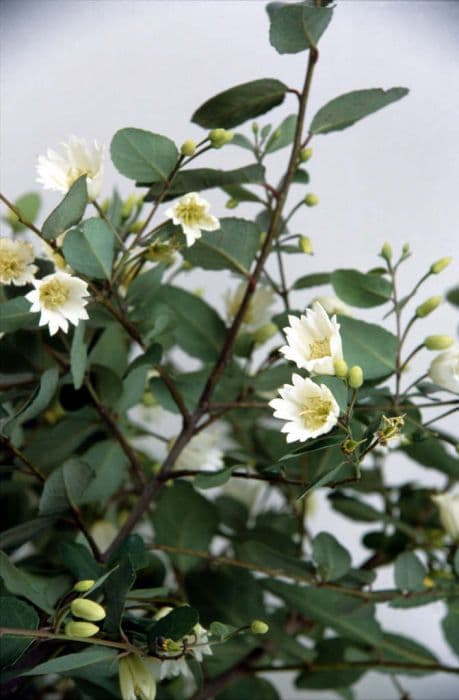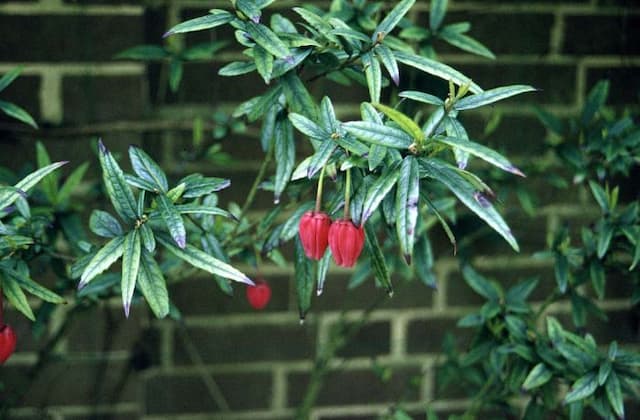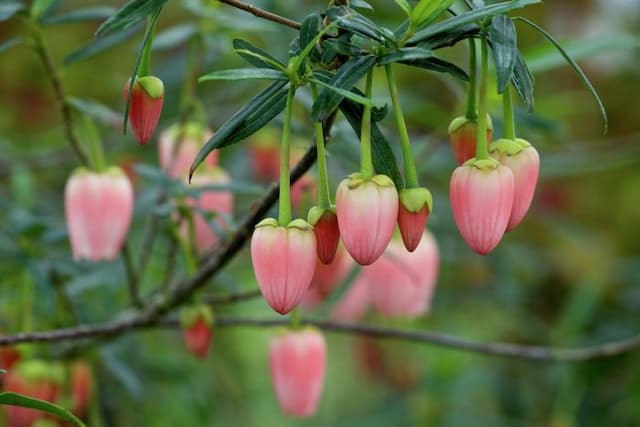Lily of the Valley Tree Crinodendron patagua

ABOUT
The plant known as Lily of the Valley tree is native to Chile and is celebrated for its striking appearance. It has a bushy and dense form with evergreen, elongated, leathery, and glossy dark green leaves. These leaves provide a year-round lush backdrop for its most remarkable feature: bell-shaped, lantern-like flowers that hang delicately from the branches. The flowers themselves are typically pure white, which contrasts beautifully with the dark foliage, making them particularly eye-catching. After the flowering season, the plant produces small, inconspicuous fruits. Overall, the appearance of the Lily of the Valley tree is both elegant and robust, with its showy blooms adding a touch of exotic charm to gardens where it is planted.
About this plant
 Names
NamesFamily
Elaeocarpaceae
Synonyms
Patagua, Lily Of The Valley Tree, Chilean Lantern Tree
Common names
Crinodendron patagua Molina, Elaeocarpus dentatus.
 Toxicity
ToxicityTo humans
The Patagua is not widely known for its toxicity to humans, and there is limited information available on its poisonous properties. If you suspect poisoning from any plant, it is essential to seek medical advice promptly, as symptoms may vary from mild to severe and can include gastrointestinal upset, dizziness, or more serious consequences depending on the plant's specific toxic compounds and the amount ingested.
To pets
The Patagua is not widely recognized for its toxicity to pets, and specific information on its poisonous effects is limited. However, as with any plant, individual animals might experience adverse reactions. Pet owners should monitor for unexpected symptoms such as vomiting, diarrhea, or lethargy and consult a veterinarian if they suspect their pet has ingested any part of a potentially toxic plant.
 Characteristics
CharacteristicsLife cycle
Perennials
Foliage type
Evergreen
Color of leaves
Green
Flower color
White
Height
10-15 feet (3-4.5 meters)
Spread
6-10 feet (1.8-3 meters)
Plant type
Tree
Hardiness zones
8
Native area
Chile
Benefits
 General Benefits
General Benefits- Aesthetic Appeal: The Crinodendron patagua, commonly known as the Patagua or Lily of the Valley tree, has attractive, glossy green leaves and produces a profusion of white, bell-shaped flowers that enhance the visual appeal of gardens and landscapes.
- Habitat Support: The flowers of the Patagua provide a valuable source of nectar for various pollinators, including bees and hummingbirds, supporting local biodiversity.
- Shade Provision: With its robust growth, the Patagua can offer a cooling canopy of shade, making it a great addition to areas that receive intense sunlight and require natural cooling.
- Ornamental Landscaping: Due to its beautiful flowers and evergreen foliage, the Patagua is often used in ornamental landscaping as a specimen or accent plant.
 Medical Properties
Medical PropertiesThis plant is not used for medical purposes.
 Air-purifying Qualities
Air-purifying QualitiesThis plant is not specifically known for air purifying qualities.
 Other Uses
Other Uses- The Patagua can be used in woodworking to create small decorative objects; its wood is hard and dense, making it suitable for intricate carvings.
- The tree's bark can be processed to make a natural dye, which can be used in traditional textile crafts.
- Bees are attracted to the flowers of the Patagua, so they can be planted to support apiculture and the local production of honey.
- Pollinated flowers of the Patagua can develop into fruit that, although not widely consumed, can be experimented with in local culinary practices.
- Its resilient wood can be used to make handles for various tools, offering durability and a good grip.
- In landscape gardening, the Patagua can be used as a hedge or screening plant due to its dense foliage.
- The branches of the Patagua tree may be used in the creation of ornamental walking sticks, prized for their unique appearance.
- The leaves of the plant can be utilized in creative arts for leaf printmaking or botanical illustration activities.
- Fallen Patagua leaves can serve as an organic mulch for garden beds, providing nutrients to the soil as they decompose.
- Patagua trees can be grown for reforestation projects, particularly in areas where they are native, contributing to the restoration of local ecosystems.
Interesting Facts
 Feng Shui
Feng ShuiThe Patagua is not used in Feng Shui practice.
 Zodiac Sign Compitability
Zodiac Sign CompitabilityThe Patagua is not used in astrology practice.
 Plant Symbolism
Plant Symbolism- Resilience: The Crinodendron patagua, commonly known as the Lily of the Valley Tree, is able to thrive in a range of soil types and withstand various climate conditions, symbolizing the ability to endure and persist through challenges.
- Elegance: With its delicate bell-shaped flowers and graceful appearance, the Lily of the Valley Tree represents elegance and refinement, much like the European flower it shares a common name with.
- Beauty: The beauty of the Lily of the Valley Tree's flowers, which bloom in profusion, can represent the idea that beauty can flourish in unexpected places and bring joy to observers.
- Secretive: The hidden nectar within the flowers of the Lily of the Valley Tree can symbolize the hidden mysteries or secrets that nature or life holds.
 Water
WaterThe Lily of the Valley Tree, or Crinodendron patagua, requires regular watering to keep its soil evenly moist, especially during dry periods. Water the plant deeply once a week, providing about 1 to 1.5 gallons of water each time for a medium-sized tree, adjusting the amount based on rainfall and temperature. During hot, dry weather, you may need to increase watering frequency. Cut back on watering during the winter when the tree is dormant, and always allow the top inch of soil to dry out between watering sessions to prevent root rot.
 Light
LightThe Lily of the Valley Tree prefers a spot with partial shade to full sun exposure. Ideally, it should be planted where it can receive dappled sunlight or morning sun and afternoon shade, especially in hotter climates. Ensuring it gets at least 4 to 6 hours of sunlight each day will help the tree to thrive and bloom optimally.
 Temperature
TemperatureThe Lily of the Valley Tree thrives in temperatures ranging from 50°F to 80°F and can tolerate a minimum temperature of around 20°F, making it suitable for USDA hardiness zones 8 through 10. Avoid exposing it to temperatures below 20°F, as severe cold can cause damage to the tree. The ideal temperature range for promoting good growth and flowering is between 60°F and 75°F.
 Pruning
PruningPruning the Lily of the Valley Tree is essential for maintaining its shape and encouraging healthy growth. Prune in late winter or early spring before new growth begins. Remove any dead, damaged, or diseased branches and thin out overgrown areas to allow light and air to reach the inner parts of the tree. Typically, an annual pruning to clean up the tree's appearance and remove unnecessary growth is sufficient.
 Cleaning
CleaningAs needed
 Soil
SoilLily of the Valley Tree prefers well-draining, humus-rich soil with a slightly acidic pH of 5.0 to 6.5. A mix of peat, perlite, and compost is ideal to ensure good drainage and fertility.
 Repotting
RepottingThe Lily of the Valley Tree should be repotted every 2 to 3 years to refresh the soil and accommodate root growth.
 Humidity & Misting
Humidity & MistingThe Lily of the Valley Tree thrives in high humidity levels, preferably between 60% to 80%. Mist regularly to maintain these conditions.
 Suitable locations
Suitable locationsIndoor
Give it bright, indirect light and high humidity indoors.
Outdoor
Plant in partial shade, shelter from wind, and mulch soil.
Hardiness zone
8-10 USDA
 Life cycle
Life cycleThe life of Crinodendron patagua, commonly known as the lily of the valley tree, begins with seed germination, which is stimulated by cold stratification, meaning the seeds require a cold period to break dormancy. Once germinated, the seedling stage involves the development of a root system and the first true leaves, which will photosynthesize to fuel growth. As the lily of the valley tree enters the juvenile phase, it focuses on rapid vegetative growth, establishing a strong stem and branching pattern. After several years, it reaches maturity and begins its reproductive stage, producing clusters of attractive white flowers which are pollinated by insects and possibly by wind, leading to the formation of seeds encased in a dry fruit. Following pollination and seed set, the fruits disperse their seeds, completing the reproductive cycle. With an established root system and regular maintenance, Crinodendron patagua can live for many years, flowering annually.
 Propogation
PropogationPropogation time
Spring-Early Summer
The Crinodendron patagua, commonly known as the Chilean Lantern Tree, is best propagated by seed, ideally sown as soon as they are ripe. Fresh seeds germinate more readily, often in the spring following the autumn harvest. To propagate by seed, one should first soak the seeds in water for 24 hours to soften the seed coat, enhancing germination. After soaking, sow the seeds at a shallow depth in a well-draining seed starting mix, maintaining a consistent moisture level. The container with the seeds should be placed in a warm area, around 70°F (21°C), under indirect light. Once seedlings have emerged and are large enough to handle, they can be transplanted into individual pots and allowed to grow on in cooler conditions before planting out into their final position during a mild period, avoiding extreme temperatures.

